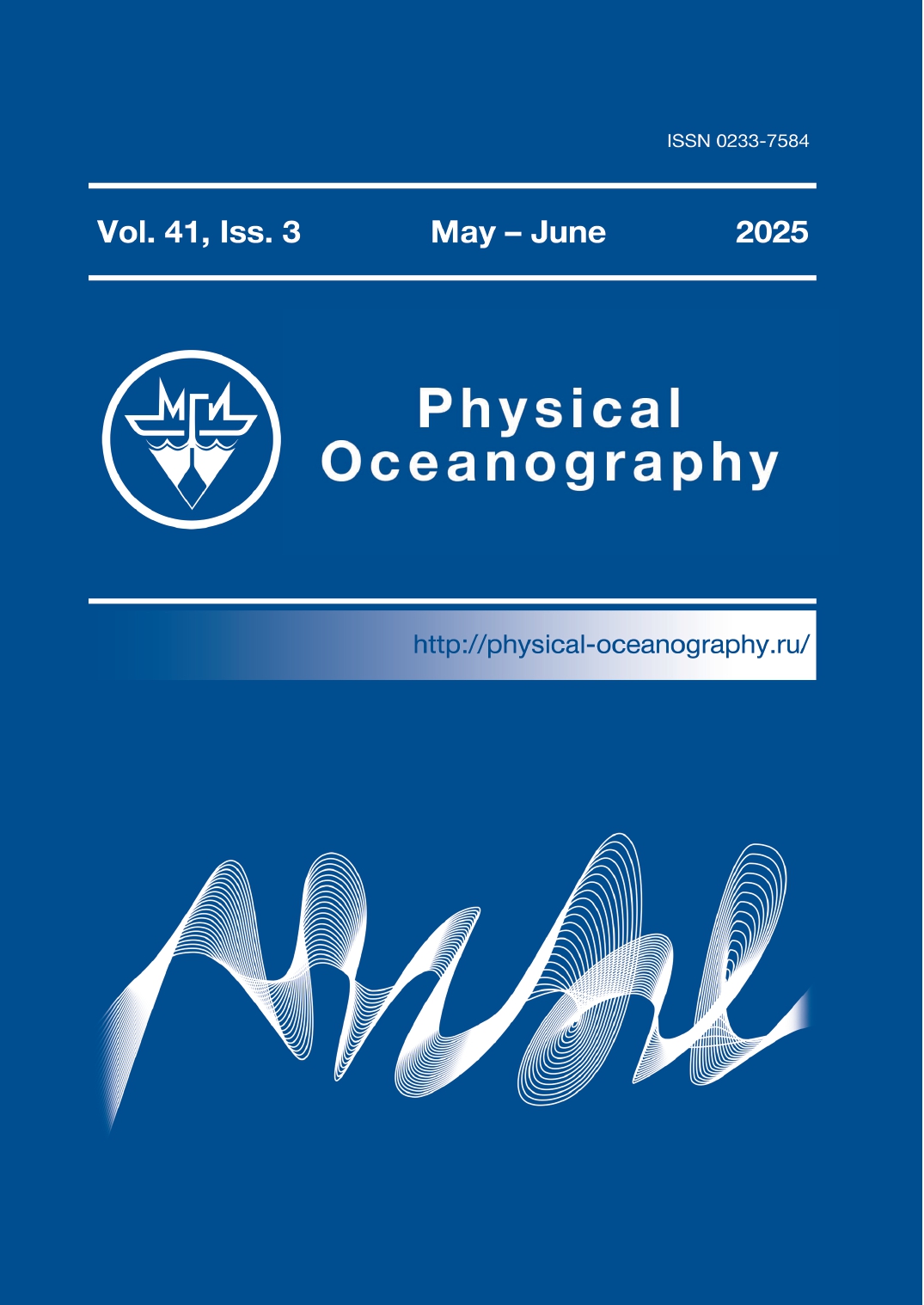Россия
Россия
Россия
Россия
Purpose. The purpose of the study is to analyze wind conditions leading to the occurrence of coastal upwelling events off the Southern Coast of Crimea (Katsiveli) in the Black Sea based on the calculations of wind upwelling index. Methods and Results. The 6-hour ERA5 reanalysis data of surface wind speed components, long-term measurements of seawater and air temperature near the coast in Katsiveli (1992–2021), as well as satellite maps of sea surface temperature are used. The upwelling index is calculated as Ekman transport driven by alongshore winds. The index is considered to be positive when the transport is directed offshore. For the Katsiveli area, this condition corresponds to winds with a western component. Negative values of the index and onshore water transport correspond to eastern winds. Calculations of the upwelling index shown that the most favorable wind conditions for upwelling events are observed in winter (December and January) and summer (June and July), driven by the high frequency of western winds. The maximum value of the upwelling index is noted in June. The statistical relationship between the monthly mean upwelling index, water temperature, number of upwellings, and the frequency and speed of western winds is analyzed for this month. It is found that the upwelling index in June correlates with the number of low water temperature events (indicative of upwelling). The correlation coefficient between them is 0.88. During the years characterized by high frequency and speed of western winds, the number of upwellings increased, whereas it was minimal when eastern winds predominated. Analysis of the variability of wind index and seawater temperature based on the 6-hour data shows that high positive values of the index correspond to the onset of upwellings, while a negative index indicates their cessation. Conclusions. Good agreement between the wind index variability and the number of measurements at low water temperature in summer demonstrates the potential of the index for studying wind conditions resulting in the development of upwelling events, as well as for forecasting their occurrence.
coastal upwelling, upwelling index, sea water temperature, wind speed, wind direction, Katsiveli, Southern Coast of Crimea, Black Sea
1. Eremeev, V.N., Boltachev, A.R., Aleksandrov, B.G., Alyomov, S.V., Zagorodnya, Yu.A.,Karpova, E.P., Manzhos, L.A. and Gubanov, V.V., 2012. Biological Diversity of the CoastalZone of the Crimean Peninsula: Problems, Preservation and Restoration Pathways. Sevastopol:Institute of Biology of the Southern Seas, 92 p.
2. Massa, F., Aydın, I., Fezzardi, D., Akbulut, B., Atanasoff, A., Beken, A.T., Bekh, V., Buhlak,Y., Burlachenko, I. [et al.], 2021. Black Sea Aquaculture: Legacy, Challenges & FutureOpportunities. Aquaculture Studies, 21(4), pp. 181-220. http://doi.org/10.4194/2618-6381-v21_4_05
3. Arrigo, K.R., 2005. Marine Microorganisms and Global Nutrient Cycles. Nature, 437(7057),pp. 349-355. https://doi.org/10.1038/nature04159
4. Varenik, A.V., Kondratyev, S.I., Medvedev, E.V., Khoruzhiy, D.S. and Orekhova, N.A., 2023.Characteristics of State and Evolution of the Black Sea Hydrochemical Structure. PhysicalOceanography, 30(6), pp. 826-850.
5. Kubryakov, A.A., Belokopytov, V.N., Zatsepin, A.G., Stanichny, S.V. and Piotukh, V.B., 2019.The Black Sea Mixed Layer Depth Variability and Its Relation to the Basin Dynamics andAtmospheric Forcing. Physical Oceanography, 26(5), pp. 397-413.https://doi.org/10.22449/1573-160X-2019-5-397-413
6. Ivanov, V.A. and Belokopytov, V.N., 2013. Oceanography of the Black Sea. Sevastopol: MHI,210 p.
7. Checkley, D.M. and Barth, J.A., 2009. Patterns and Processes in the California Current System.Progress in Oceanography, 83(1-4), pp. 49-64. https://doi.org/10.1016/j.pocean.2009.07.028
8. Stelmakh, L.V., 2020. Methodology of Comprehensive Monitoring of Modern Black SeaPhytoplankton Community Status. Monitoring Systems of Environment, (1), pp. 21-26.https://doi.org/10.33075/2220-5861-2020-1-21-26 (in Russian).
9. Finenko, Z.Z., Mansurova, I.M., Kovalyova, I.V. and Georgieva, E.Yu., 2021. Development ofPhytoplankton in the Winter-Spring Period in the Coastal Waters of Crimea. Marine BiologicalJournal, 6(1), pp. 102 -114. https://doi.org/10.21072/mbj.2021.06.1.08 (in Russian).
10. Kostianaia, E.A. and Kostianoy, A.G., 2021. Regional Climate Change Impact on CoastalTourism: A Case Study for the Black Sea Coast of Russia. Hydrology, 8(3), 133.https://doi.org/10.3390/hydrology8030133
11. Kämpf, J. and Chapman, P., 2016. The Functioning of Coastal Upwelling Systems. In: J. Kämpfand P. Chapman, 2016. Upwelling Systems of the World. A Scientific Journey to the MostProductive Marine Ecosystems. Cham: Springer, pp. 31-65. https://doi.org/10.1007/978-3-319-42524-5_2
12. Jacox, M.G. and Edwards, C.A., 2011. Effects of Stratification and Shelf Slope on NutrientSupply in Coastal Upwelling Regions. Journal of Geophysical Research: Oceans, 116(C3),C03019. https://doi.org/10.1029/2010JC006547
13. Zatsepin, A.G., Silvestrova, K.P., Piotoukh, V.B., Kuklev, S.B. and Podymov, O.I., 2016. Observations of a Cycle of Intense Coastal Upwelling and Downwelling at the Research Site of the Shirshov Institute of Oceanology in the Black Sea. Oceanology, 56(2), pp. 188-199. https://doi.org/10.1134/S0001437016020211
14. Silvestrova, K.P., Zatsepin, A.G. and Myslenkov, S.A., 2017. Coastal Upwelling inthe Gelendzhik Area of the Black Sea: Effect of Wind and Dynamics. Oceanology, 57(4),pp. 469-477. https://doi.org/10.1134/S0001437017040178
15. Gawarkiewicz, G., Korotaev, G., Stanichny, S., Repetin, L. and Soloviev, D., 1999. SynopticUpwelling and Cross-Shelf Transport Processes along the Crimean Coast of the Black Sea.Continental Shelf Research, 19(8), pp. 977-1005. https://doi.org/10.1016/S0278-4343(99)00003-5
16. Goryachkin, Yu.N., 2018. Upwelling nearby the Crimea Western Coast. Oceanography, 25(5),pp. 368-379. https://doi.org/10.22449/1573-160X-2018-5-368-379
17. Stanichnaya, R.R. and Stanichny, S.V., 2021. Black Sea Upwellings. Current Problems inRemote Sensing of the Earth from Space, 18(4), pp. 195-207. https://doi.org/10.21046/2070-7401-2021-18-4-195-207 (in Russian).
18. Kubryakov, A., Aleskerova, A. and Mizyuk, A., 2024. Submesoscale Features of CoastalUpwellings in the Black Sea: Observations and Modeling. Continental Shelf Research, 279,105291. https://doi.org/10.1016/j.csr.2024.105291
19. Lovenkova, E.A. and Polonskii, A.B., 2005. Climatic Characteristics of Upwelling nearthe Crimean Coast. Russian Meteorology and Hydrology, (5), pp. 31-37.
20. Kuklin, A.K., Kuklina, N.Ya. and Shabalina, O.A., 2014. [Sea Water Temperature nearthe Oceanographic Platform in Katsiveli]. Ecological Safety of Coastal and Shelf Zones andComprehensive Use of Shelf Resources, 28, pp. 186-194 (in Russian).
21. Shokurova, I.G., Plastun, T.V., Kasianenko, T.E., Stanichnaya, R.R., Krasheninnikova, S.B. andSimonova, Yu.V., 2023. Winds Favorable for Upwellings near the Southern Coast of Crimea.Physical Oceanography, 30(4), pp. 398-409.
22. Tolstosheev, A.P., Motyzhev, S.V. and Lunev, E.G., 2020. Results of Long-Term Monitoring ofthe Shelf Water Vertical Thermal Structure at the Black Sea Hydrophysical Polygon of RAS.Physical Oceanography, 27(1), pp. 69-80. https://doi.org/10.22449/1573-160X-2020-1-69-80
23. Simonova, Yu.V., Stanichny, S.V. and Lemeshko, E.M., 2024. The Features of Anomalies inSurface Temperature of the Black Sea in the Area of the Southern Coast of Crimea.Sovremennye Problemy Distantsionnogo Zondirovaniya Zemli iz Kosmosa, 21(3), pp. 234-243.https://doi.org/10.21046/2070-7401-2024-21-3-234-243 (in Russian).
24. Silvestrova, K.P., Myslenkov, S.A. and Repkov, D.S., 2022. Wind Upwelling Forecast forthe Russian Black Sea Coast. Hydrometeorological Research and Forecasting, 1(383), pp. 89-107. https://doi.org/10.37162/2618-9631-2022-1-89-107
25. Ivanov, V.A. and Mikhailova, E.N., 2008. Upwelling in the Black Sea. Sevastopol: ECOSI-Gidrofizika, 92 p. (in Russian).
26. Polonskii, A.B. and Muzyleva, M.A., 2016. Modern Spatial-Temporal Variability of Upwellingin the North-Western Black Sea and off the Crimea Coast. Izvestiya Rossiiskoi Akademii Nauk. Seriya Geograficheskaya, (4), pp. 96-108. https://doi.org/10.15356/0373-2444-2016-4-96-108 (in Russian).
27. Bakun, A., 1973. Coastal Upwelling Indices, West Coast of North America, 1946–71. NOAATechnical Report NMFS SSRF. Seattle, WA: National Marine Fisheries Service, 103 p.
28. Pérez, F.F., Padín, X.A., Pazos, Y., Gilcoto, M., Cabanas, M., Pardo, P.C., Doval, M.D. andFarina‐Busto, L., 2010. Plankton Response to Weakening of the Iberian Coastal Upwelling.Global Change Biology, 16(4), pp. 1258-1267. https://doi.org/10.1111/j.1365-2486.2009.02125.x
29. González-Nuevo, G., Gago, J. and Cabanas, J.M., 2014. Upwelling Index: A Powerful Tool forMarine Research in the NW Iberian Upwelling System. Journal of Operational Oceanography,7(1), pp. 47-57. https://doi.org/10.1080/1755876X.2014.11020152
30. Ferreira, S., Sousa, M., Picado, A., Vaz, N. and Dias, J.M., 2022. New Insights about UpwellingTrends off the Portuguese Coast: An ERA5 Dataset Analysis. Journal of Marine Science andEngineering, 10(12), 1849. http s://doi.org/10.3390/jmse10121849
31. Zhabin, I.A., Dmitrieva, E.V., Dubina, V.A. and Luchin, V.A., 2022. Variability of SummerWind-Driven Upwelling along the Koryak Coast in the Northwestern Bering Sea Based onSatellite Data. Izvestiya, Atmospheric and Oceanic Physics, 58(12), pp. 1438-1449.https://doi.org/10.1134/S0001433822120283
32. Mihailov, M.E., 2024. The Black Sea Upwelling System: Analysis on the Western ShallowWaters. Atmosphere, 15(8), 999. https://doi.org/10.3390/atmos15080999
33. Jacox, M.G., Edwards, C.A., Hazen, E.L. and Bograd, S.J., 2018. Coastal Upwelling Revisited:Ekman, Bakun, and Improved Upwelling Indices for the U.S. West Coast. Journal ofGeophysical Research: Oceans, 123(10), pp. 7332-7350. https://doi.org/10.1029/2018JC014187
34. Zhuk, E., Khaliulin, A., Zodiatis, G., Nikolaidis, A. and Isaeva, E., 2016. Black Sea GISDeveloped in MHI. In: SPIE, 2016. Proceedings of SPIE. Volume 9688, Fourth InternationalConference on Remote Sensing and Geoinformation of the Environment (RSCy2016), 96881C.https://doi.org/10.1117/12.2241631
35. Hersbach, H., Bell, B., Berrisford, P., Hirahara, S., Horányi, A., Muñoz‐Sabater, J., Nicolas, J.,Peubey, C., Radu, R. [et al.], 2020. The ERA5 Global Reanalysis. Quarterly Journal ofthe Royal Meteorological Society, 146(730), pp. 1999-2049. https://doi.org/10.1002/qj.3803













